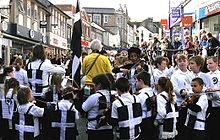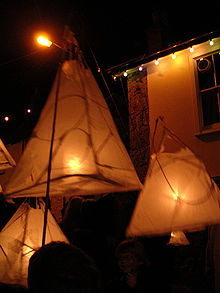- Cornish folklore
-
Cornish folklore is the folk tradition which has developed in Cornwall. There is much traditional folklore in Cornwall, often tales of giants, mermaids, Bucca, piskies or the 'pobel vean' (little people.) These are still surprisingly popular today, with many events hosting a 'droll teller'[1] to tell the stories: such myths and stories have found much publishing success, particularly in children's books. The fairy tale Jack the Giant Killer takes place in Cornwall. Many early British legends associate King Arthur with Cornwall putting his birthplace at Tintagel, the court of his uncle King Mark of Cornwall, father of Tristan & Iseult the most famous Cornish lovers.
Contents
Overview
Cornwall shares its ancient cultural heritage with its 'Brythonic cousins' Brittany and Wales, as well as Ireland and parts of England such as neighbouring Devon. Many ancient tales of the Bards, whether the Arthurian Cycle, Tristan and Iseult or the Mabinogion take place in the ancient kingdom of Cerniw between Greater and Lesser Britains with a foot on either side of the 'British Sea' Mor Brettanek/Mor Breizh.
Part of Cornish folklore is derived from tales of sea-faring pirates and smugglers who thrived in and around Cornwall from the early modern period through to the 19th century. Cornish pirates exploited both their knowledge of the Cornish coastline as well as its sheltered creeks and hidden anchorages. For many fishing villages, loot and contraband provided by pirates supported a strong and secretive underground economy in Cornwall.[2]
Legendary creatures that appear in Cornish folklore include buccas, knockers and piskies.[3] Tales of these creatures are thought to have developed as supernatural explanations for the frequent and deadly cave-ins that occurred during 18th century Cornish tin mining, or else a creation of the oxygen-starved minds of exhausted miners who returned from the underground.
The knocker or bucca (Cornish) is the Welsh and Cornish equivalent of Irish leprechauns and English and Scottish brownies. About two feet tall and grizzled, but not misshapen, they live beneath the ground. Here they wear tiny versions of standard miner's garb and commit random mischief, such as stealing a miner's unattended tools and food - they were often cast a small offering of food - usually the crust of a pasty to appease their malevolence.
- Weather lore
"Mist from the hill / Brings water for the mill; / Mist from the sea /Brings fine weather for me."[4] "Lundy plain, Sign of rain" (current in north Cornwall where Lundy Island is normally visible).
Enys Tregarthen
Nellie Sloggett of Padstow devoted much of her attention to Cornish folklore and legend. She collected and recorded many stories about the Piskey folk, fairies of Cornish myth and legend. She published most of her works in this category under her better-known pen-name of Enys Tregarthen.[5]
- Books
- The Doll Who Came Alive (1973) ISBN 0-381-99683-2
- Pixie Folklore & Legends (reprinted 1995) ISBN 0-517-14903-6
- Padstow's Faery Folk (Paperback)
- North Cornwall Fairies and Legends (1906)
- The House of the Sleeping Winds and Other Stories (1911)
- The White Ring (1949)
North Cornwall
Dozmary Pool is identified by some people with the lake in which, according to Arthurian legend, Sir Bedivere threw Excalibur to The Lady of the Lake.[6] Another legend relating to the pool concerns Jan Tregeagle.
The Beast of Bodmin has been reported many times but never identified with certainty.
According to legend, the Mermaid of Padstow created the Doom Bar as a dying curse, after being shot by a sailor. However, there are many different versions of the story and the precise details are unclear. Some versions start by stating that she used to guide ships up the estuary and others that she would visit and spy upon ships in harbour, yet more tell of how she used to sit upon a rock at Hawkers Cove. She then met a man, and one fell in love with the other. One version explains that she was love sick, and tried to lure him beneath the waves, however he escaped by shooting her.[7] Another version suggested the man, Tristram Bird, fell in love with her and asked her to marry him, though she refused. In his rage he shot her.[8] Another suggestion is that a fisherman, Tom Yeo, shot her because he thought she was a seal. The ending of the legend is generally similar. With her dying breath, she leveled a curse at Padstow, or at the harbour itself, stating that the harbour will be desolate or unsafe. With that, a great storm came, wrecking many boats and creating the great sand bank known as the Doom Bar.
Penwith
Within the bounds of Gulval parish lies the disused Ding Dong mine, reputedly one of the oldest in Cornwall. Popular local legend claims that Joseph of Arimathea, a tin trader, visited the mine and brought a young Jesus to address the miners, although there is no evidence to support this [9][10]
At Zennor there is a legend of the Mermaid of Zennor and at Mousehole, Tom Bawcock is a legendary fisherman from the village who according to legend risked his life to go out and fish and managed to come back with enough fish to feed the village until the storm was over. All the fish was put into a big pie, and the pie called "Stargazy pie".
The Merry Maidens stone circle at St Buryan: the local myth about the creation of the stones suggests that nineteen maidens were turned into stone as punishment for dancing on a Sunday. (Dans Maen translates as Stone Dance.) The pipers, two megaliths some distance north-east of the circle, are said to be the petrified remains of the musicians who played for the dancers. A more detailed story explains why the Pipers are so far from the Maidens - apparently the two pipers heard the church clock in St Buryan strike midnight, realised they were breaking the sabbath, and started to run up the hill away from the maidens who carried on dancing without accompaniment. These petrifaction legends are often associated with stone circles, and is reflected in the folk names of some of the nearby sites, for example, the Tregeseal Dancing Stones, the Nine Maidens of Boskednan, as well as the more distant Hurlers and Pipers on Bodmin Moor.
See also
- Peter and the Piskies: Cornish Folk and Fairy Tales
- Culture of Cornwall
- List of Cornish saints
- Jan Tregeagle
- William Henry Paynter
- Matter of Britain
- Corineus - mythical founder of Cornwall
- Cormoran - the Giant and his wife of St Michael's Mount
- Hunting of Twrch Trwyth - the Cornish Boar of Welsh legend
- Blunderbore
- Cornish festivals
- History of Brittany - the brother nation over the sea
- Welsh Mythology
- King Arthur & Celliwig
- Tristan and Iseult - a Cornish love story
- Lyonesse & Ys - the Cornish & Breton Atlantis
References
- ^ Cornish Folk Tales, Mike O'Connor (Gorsedh Kernow)
- ^ Andrews, Robert; Brown, Jules; Humphreys, Rob; Lee, Phil; Reid, Donald; Whitfield, Paul (2006), The Rough Guide to Britain, Rough Guides, ISBN 9781843536864
- ^ Steves, Rick (2007), Rick Steves' England 2008, Avalon Travel, ISBN 9781598800975
- ^ Holloway, John, ed. (1987) The Oxford Book of Local Verses. Oxford U. P.; p. 104
- ^ "Introduction to Cornish Fairy Folk Tales". http://www.gandolf.com/cornwall/fairies/introduction.shtml.
- ^ Cornish Archaeology; No 34 1995
- ^ Into Cornwall Guide, http://www.intocornwall.com/engine/azabout.asp?id=52&code=P, retrieved 2009-02-04
- ^ About Padstow, http://www.piran-pewter.demon.co.uk/aboutuspage.htm, retrieved 2009-02-04[dead link]
- ^ Matthews, John (ed.) (1991) 'A Glastonbury Reader: Selections From the Myths, Legends and Stories of Ancient Avalon'. London: HarperCollins (reissued by The Aquarian Press)
- ^ "Joseph of Arimathea". Hope of Israel (organization). http://www.hope-of-israel.org/i000111a.htm. Retrieved 2009-06-11.
Further reading
- Addicoat, Ian & Buswell, Geoff Mysteries of the Cornish Coast: legends, ghosts and extraordinary events from Cornwall's south-west peninsula. Tiverton: Halsgrove, 2003 ISBN 1841142557
- Baring-Gould, Sabine A Book of the West. II: Cornwall. London: Methuen, 1899
- Bottrell, William Traditions and Hearthside Stories of West Cornwall. 3 vols. Penzance: printed for the author, 1870, 1873, 1880
- Couch, Jonathan The History of Polperro.
- Couch, Mabel Cornwall's Wonderland. London: J. M. Dent, 1914 (Contents: How Corineus fought the chief of the giants.--The giant of St. Michael's Mount.--The legend of the Tamar, the Tavy, and the Taw.--The strange story of Cherry Honey.--The fairies on the Gump.--The fairy ointment.--The exciting adventure of John Sturtridge.--The true story of Anne and the fairies.--Barker and the Buccas.--Lutey and the mermaid.--The wicked spectre.--The story of the lovers' cove.--The silver table.--Cruel Coppinger, the Dane.--Madge Figgy, the wrecker.--How Madge Figgy got her pig.--The story of Sir Tristram and La Belle Isoult.)
- Courtney, Margaret Ann Folklore and Legends of Cornwall. 1890
- Evans-Wentz, W. Y. The Fairy-Faith in Celtic Countries. 1911
- Gary, Gemma Traditional Witchcraft: a Cornish Book of Ways. Troy Books, 2008
- Jenkin, A. K. Hamilton Cornwall and the Cornish: the story, religion and folk-lore of ’The Western Land’'. 1933
- Lach-Szyrma, W. S. "M. Sebillot's System as applied to Cornish Folk-lore". Transactions of the Penzance Natural History and Antiquarian Society. New Series, 1882, pp. 132-150.
- Matthews, John Hobson (1892) A History of the Parishes of Saint Ives, Lelant, Towednack, and Zennor, in the County of Cornwall; chapter: Legendary Lore. London: Elliot Stock (Reprinted: St Ives: St. Ives Trust and St. Ives Library, 2003)
- Paynter, William H. & Semmens, Jason The Cornish Witch-finder: The Witchery, Ghosts, Charms and Folklore of Cornwall. Federation of Old Cornwall Societies, 2008
- Semmens, Jason The Witch of the West: Or, The Strange and Wonderful History of Thomasine Blight. Plymouth, 2004.
- Semmens, Jason “A Case of Witchcraft in Camborne during the Late Seventeenth Century?” Old Cornwall 12, No. 3 (1998) pp. 3, 4.
- Semmens, Jason "The Usage of Witch-Bottles and Apotropaic Charms in Cornwall.” Old Cornwall 12, No. 6 (2000) pp. 25–30.
- Semmens, Jason "The Magus in Cornwall: An Unknown Chapter in the Life of Francis Barrett, F.R.C.” Old Cornwall 13, No. 1 (2003) pp. 18–21.
- Semmens, Jason "An Account of One Ann Jeffries: Notes on the Background to the Curious Case of the Maid of St. Teath.” Old Cornwall 13, No. 3 (2004) pp. 10–15.
- Semmens, Jason '“Whyler Pystry”: A Breviate of the Life and Folklore-Collecting Practices of William Henry Paynter (1901–1976) of Callington, Cornwall.” Folklore 116, No. 1 (2005) pp. 75–94.
- Semmens, Jason "A Cure from the Cunning.” Cornish World 42 (2005) pp. 62–67.
- Semmens, Jason “Old and a Trouble”: Notes on the Life of Granny Boswell.” Meyn Mamvro 57 (2005) pp. 20–22.
- Semmens, Jason "Tales of Cornish Witches.” Old Cornwall 13, No. 7 (2006) pp. 22–27.
- Semmens, Jason "Folk-magic in East Cornwall: A Nineteenth-century Conjuror’s Archive from North Tamerton.” Old Cornwall 13, No. 10 (2008) pp. 20–26.
- Semmens, Jason "On the Origin of ‘Peller.’” Old Cornwall 14, No. 1 (2009) pp. 43–50.
External links
Culture of Cornwall Symbols 
Festivals Sports Cuisine Arts Music Cornish bagpipes · Brenda Wootton · Gwenno Saunders · Fisherman's Friends
Folk songsLanguage Folklore Beast of Bodmin · Blunderbore · Bucca · Cruel Coppinger · Knocker · King Arthur · Lyonesse · Owlman · Piskie
Organisations Cornwall portal Categories:- Cornish culture
- Cornish folklore
- Cornwall
Wikimedia Foundation. 2010.




